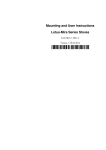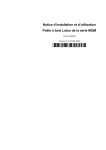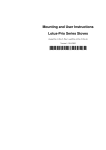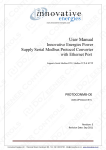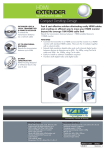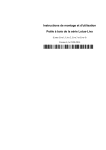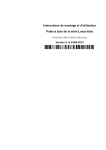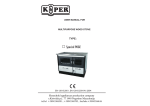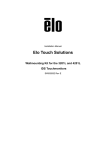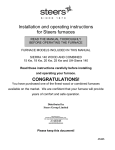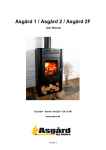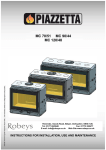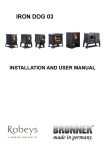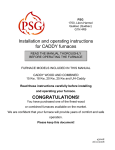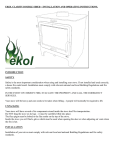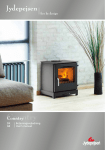Download Installation & User Instructions - Lotus Wood Burning Stoves & Fires
Transcript
Mounting and User Instructions
Lotus-Mondo Series Stoves
(Lotus Mondo 1, Lotus Mondo 2, Lotus Mondo 1 Petite)
Version 1, 15.10.12
Introduction
Congratulations on your new Lotus Fireplace Insert
We hope and believe that it will give you many warm hours. But before you may truly
benefit from your investment, you should read this guide thoroughly. It provides some
specific advice as to how you will benefit the most from your fireplace insert – now, as well
as in the years to come. This is why this guide would be worth while keeping, like all other
directions for use.
Lotus may look back on a long tradition, making our first productions back in 1979. Our
production is now run at Langeskov, and exported to many European markets. Lotus
products are made to a fine Danish tradition, serving its owners faithfully for years. So, once
again congratulations on your new Lotus fireplace insert – making for a warm and cosy
beginning of an all new home life for you.
The Clean Air Act 1993 and Smoke Control Areas
Under the Clean Air Act local authorities may declare the whole or part of the district of the
authority to be a smoke control area. It is an offence to emit smoke from a chimney of a
building, from a furnace or from any fixed boiler if located in a designated smoke control
area. It is also an offence to acquire an "unauthorised fuel" for use within a smoke control
area unless it is used in an "exempt" appliance ("exempted" from the controls which
generally apply in the smoke control area).
The Secretary of State for Environment, Food and Rural Affairs has powers under the Act to
authorise smokeless fuels or exempt appliances for use in smoke control areas in England.
In Scotland and Wales this power rests with Ministers in the devolved administrations for
those countries. Separate legislation, the Clean Air (Northern Ireland) Order 1981, applies in
Northern Ireland. Therefore it is a requirement that fuels burnt or obtained for use in smoke
control areas have been "authorised" in Regulations and that appliances used to burn solid
fuel in those areas (other than "authorised" fuels) have been exempted by an Order made and
signed by the Secretary of State or Minister in the devolved administrations.
The Lotus Mondo 1-Mondo 2 and Mondo 1 Petite has been recommended as suitable
for use in smoke control areas when burning untreated wood only.
Further information on the requirements of the Clean Air Act can be found here:
http://smokecontrol.defra.gov.uk/
Your local authority is responsible for implementing the Clean Air Act 1993 including
designation and supervision of smoke control areas and you can contact them for details of
Clean Air Act requirements.
Refuelling on to a low fire bed
If there is insufficient burning material in the firebed to light a new fuel charge, excessive
smoke emission can occur. Refuelling must be carried out onto a sufficient quantity of
glowing embers and ash that the new fuel charge will ignite in a reasonable period. If there
are too few embers in the fire bed, add suitable kindling to prevent excessive smoke
Fuel overloading
The maximum amount of fuel specified in this manual should not be exceeded, overloading
can cause excess smoke.
Operation with door left open
Operation with the door open can cause excess smoke. The appliance must not be operated
with the appliance door left open except as directed in the instructions.
Dampers left open
Operation with the air controls or dampers open can cause excess smoke. The appliance
must not be operated with air controls or dampers door left open except as directed in the
instructions.
Distance to Combustible Material
For combustible material, such as combustible walls, furniutre, etc., for reasons of
safety a number of minimum distances apply. The following minimum distances
apply: For Mondo 1, Mondo 2
Uninsulated flue
Insulated flue
A: 75mm
A:50mm
B:200 mm
B:50 mm
C:375 mm
C:375 mm
1000mm in front of the stove
The following minimum distances apply: For Mondo 1 Petite
Uninsulated flue
Insulated flue
A: Not testet
A: Not testet
B:200 mm
B:100 mm
C:360 mm
C:350 mm
1200mm in front of the stove
Distance to non-combustible material
For non-combustible material, there should be a distance of 80-100 mm in order that
the stove may release and distribute the heat while you may clean on and around the
stove.
Technical Specifcations
Model
Mondo 1
Mondo 2
Mondo 1
Petite
Height
96cm
96cm
76cm
Width
48cm
48cm
48cm
Mean Values at testing to DS/EN 13240:
Flues Gas Temperature:
359 C
Flue Gas Mass Flow:
4,9 g/s
Rate of Efficiency:
78,8%
Rated Output:
5.1 Kw
Flue:
12 pa
Depth
37cm
41cm
37cm
Weight
108kg
109kg
104kg
Chimney
A good draught in your chimney is paramount to how well a stove will burn. Note that
there should be access to cleaning doors.
The effective height of your chimney should typically range between 3.5 and 4.5
metres. Effective height is to be understood as the distance from the stove top to the
top of the chimney. The inside diameter of the chimney should be min. 150 mm
(inside dimension).
All joints and connection points shall, of course, be tight, and the chimney shall be
able to provide a draught of a min. 1.2 mm water column (12 Pa), though preferably a
little more.
The wood stove may be connected to chimneys which are also used for other purposes.
To this end, the specific local conditions shall be assessed by a fitter and/or chimney
sweep.
Register
If your chimney has a register, it should have a forced aperture of min. 20 cm2.
Mounting of Smoke Baffle Plates
Below, it has been shown how the smoke baffle plates are to be placed when viewing a
section in the stove from the side.
Baffle plate
Each smoke baffle plate is to be removed separately. Both smoke baffle plates are
removed by lifting up at one side after which they may come clear at the other side and
be taken down into the combustion chamber and out of the door. Similarly, they are
put in place by leading them up slanting-wise at one side, and then at the other side,
and they are then put into place in the middle.
Combustion Air Supply
It is important for good and clean burning that adequate air be supplied to the fire. To
allow for this, it is, however, a condition that air be supplied to the room in which the
stove has been set up.
Certainly most rooms will have sufficient air, not least if some of the doors between
the rooms of the house are open. In special cases, an air valve may have to be put in
the exterior wall of the room in which the stove has been put up.
Floor
When placing your new Lotus stove on the floor, it should be put on a noncombustible plate, for instance of steel or stone material. The plate should be so large
that it will reach a minimum of 30 cm in front of the stove, and 15 cm at each side of
the fireplace opening.
Chimney Sweep
When your new stove has been mounted, do remember to report the installation to the
chimney sweep. For one thing, the installation will have to be inspected, and the
chimney should also be cleaned by the chimney sweep in the time ahead.
Use of stove
Below, the procedure applied at the stove testing by Teknologisk Institut – The
Technological Institute – has been reviewed. This is the procedure generating optimal
combustion on the particular chimney.
Wood quantity and register setting may be varied as individually required for heating
and the draught of the particular chimney. The stove has been tested with birch wood
of a humidity of appr. 18%.
Kindling and Current Stoking at EN Test
1. The ash pan as well as the grate must always be closed completely, also when
kindling.
2. Put about 2 kg kindling wood into the bottom of the stove, stacked crisscross like a
log house. Put 2 fire-lighters in the middle, and ignite them.
3.
4.
5.
6.
Close the door ajar, leaving an aperture of appr. 3 cm. Open the register under the
door completely (turning it to the left). Leave the stove like this for about 8-10
minutes before closing the door completely and turning the handle into locked
position
The register is damped as required during the kindling.
When the fire has burned down to embers (no more flames), open the door gently so
as not to whirl out the embers. Spread out the embers cautiously using a poker so as
to leave them in an even layer.
Put three pieces of wood into the stove, totally about 1.7 kg. The foremost piece will
ignite best if it has a split side facing the door, and one down in the embers. Close
the door immediately and completely.
7. The damper may be opened entirely and damped again once the fire has caught on
well. Just how much the damper should be opened may vary with the draught of the
particular chimney but the flames are now to stabilize so as to assume the
appearance of a “calmly” burning fire.
8.
When the wood has burned down to embers (after about one hour), start all over
from item 5.
Ashes
Ashes may be discarded in the waste bin for refuse collection. The ashes should
always have cooled for 24 to 48 hours before being thrown into the waste bin as there
may otherwise still be embers that may ignite waste or the waste bag.
Sound Advice
Kindling after a protracted interval
If your stove has not been used for some considerable time, the chimney should b
inspected for blocking prior to rekindling.
Cleaning of Stove
All Lotus stoves have been factory surface treated with original Senotherm lacquer
in”coke” or”grey” colour. Due to this treatment, the stove will, during the first
kindlings, exude a special odour but that will vanish after a few times. Good airing to
be provided. The surface is maintained by brushing it using a soft, long-haired auto
brush or by using the vacuum cleaner with a brush.
Your stove should also be cleaned inside regularly. Ashes, soot, and any tar residues
are to be removed from pane and combustion chamber. Smoke baffle plates should be
dismantled regularly to remove soot and dirt which will frequently settle behind the
plates. Check at the same time whether there is free passage to the chimney. The ash
pan should also be emptied regularly as required. The ashes from the wood stove may
contain embers long after the stove was used last time so always put the ashes in a
fireproof bucket prior to removal. Do remember that your stove should be cleaned in
cold condition only.
Chimney Fire
In case of a chimney fire, doors and register should be shut so as to cut off the oxygen
supply. Relevant authorities etc. may be called if necessary.
Stove Maintenance – use original spare parts only
Packings may seem to look nice; they will, however, collapse in the heat, thereby
losing their ability to keep your stove tight. Packings should be replaced as required as
it is essential to good combustion and to a clean pane that your stove is tight.
The shaker grate may in extremely rare cases become worn or crack after use and
may also be easily replaced. Lift the grate and the frame a couple of cm, release from
draw bar, and replace by a new one. The actual frame holding the grate may also be
easily replaced as it lies loose in the Skamol.
The combustion chamber covering may break or become worn. The panels are made
of vermiculite, an insulation material. When worn, the material is to be replaced not
later than when the panels have a thickness of appr. 1.5-2.0 cm. The material is
slightly porous. To prevent breaking of the panels it should be ensured that the board
is not thrown but laid in the middle of the combustion chamber. If you happen to break
a Skamol panel, this will not have any impact on the insulating effect of the panel.
Painting of your stove using Senotherm spray may cover stains or small scratches
from kettles or other. Heavy damage to be ground with fine steel wool, vacuum
cleaned, and then sprayed. Shake the spray can very heavily, and spray on at a distance
of 15-20 cm. It is most important that your stove will be out of operation and quite
cold before you use your spray, otherwise heavy damage may be inflicted on account
of fire risk.
Kindling Wood
Kindling wood is the designation for finely split small wood/sticks some 20 cm long
and having a diameter of 2-3 cm.
Wood
Birch, beech, oak, ash, elm, as well as fruit trees are all suitable for being chopped into
firewood.
Exemption of the Mondo1, Mondo2 and Mondo Petite for use in a smoke control area
applies when burning untreated wood only.
Pressure impregnated wood, chipboard, coloured leaflets or glazed paper are, however,
not suitable in a stove. They will develop Hydrochloric acid or heavy metals much to
the detriment of your stove and to the environment.
Wood for your Lotus stove should have a diameter of 7-9 cm and be max. appr. 30 cm
long as it will otherwise come too close to the stove sides (at the DS testing 25 cm
long wood has been used). The most important aspect of good combustion is that your
wood will be appropriately dry (of a humidity of 15-20%). If your wood is too wet,
making it burn will be hard, the chimney draught will not occur, there will be a lot of
smoke, and utilization will be low as water will need to evaporate first. This is
certainly harmful to the environment and will cause a high level of emission. Further,
it may cause damage to your stove and chimney by way of shining soot and tar
coverings. “Worst Case” would be a chimney fire. If your wood is far too dry, it will
burn too quickly. Frequently the gases in the wood will be released quicker than they
will burn, and some part of these will go up the chimney unburned. Thus yielding a
lower rate of utilization and harming the environment.
So it is a matter of a balance which is, however, reasonably easy to find with a little
practice.
Also please refer to the comments below under Storage.
Storage of Wood
The best storage of the wood is under roof though still with good airing, for instance
in a car port or under a shed roof. Preferably put your wood on a wooden pallet or
similar, clear of the ground. Fresh wood, sawn and chopped, should preferably be left
in this manner for one or two years depending on the species of wood.
Items available in stove
In the stove, the present mounting and user instructions are available, as well as a
glove good for stoking.
Operating Trouble
In case of any operating trouble with your Lotus stove, you may find the cause of that
below. If not, please do not hesitate to contact your Lotus distributor.
Stove hard to control – burning too quickly
If your stove is new, check our guide.
If your stove is more than one year old, or if it has been used heavily, the packings
may have to be replaced. If the packings are on for too long, the heat will cause the
packings to lose their ability to keep your stove tight.
Stove drawing badly after installation
Check that the mounting instructions have been followed. In particular, conditions
around the chimney may cause trouble. Are the diameter and the length OK, is it tight,
and are the flue pipes and the transitions tight? A chimney sweep may have to be
contacted to remedy the problem as the chimney may be clogged.
Smelling of Smoke and Soot
This may be due to wind down draught in the chimney and will mostly occur in certain
wind directions. The chimney may be too short in relation to the roof ridge, or trees
may have grown up and may be causing turbulence.
Your stove is hard to make burn and may go out
There may be a number of reasons for this. The most typical ones are:
The register is not open enough.
The wood is too wet.
The chimney draught is too small; it may be clogged or leaky.
The layer of embers was too small/no longer glowing and did not produce heat enough
to kindle the pieces of wood. A little primary air may be supplied by pulling out the
ash pan a little and opening the grate a little to get the stove going again after which
you close again completely.
Depending on the type of problem you may have to contact your Lotus distributor or a
chimney sweep.
Lotus Wood Stove
5-Year Warranty
This warranty covers Lotus Wood Stove model _________ production no. _____________
purchased on the ____________.
This warranty covers normal firing – i.e. using ordinary chopped wood and pressed wood
briquettes, and only provided the stove is otherwise operated to the specifications of the
directions for use.
This warranty covers the faultless function of the stove, and does not cover overheating
damage, damage to lacquer, wearing parts and movable parts such as glass, Skamol, stones,
shaker grate, smoke baffle plates, packings, slide gate, and closing gear.
This warranty shall lapse if this stove is not operated so as to comply with the directions for
use, and if deficiencies or similar are aimed to be/are remedied by a person not authorized
by Lotus Heating Systems A/S. This warranty does not cover damage caused by
inappropriate, non-expert/incompetent use of the stove.
If a product is returned to Lotus Heating Systems A/S, and the damage subsequently turns
out not to be covered by this warranty, any costs incurred shall be incumbent on the
customer.
For any warranty repair, the warranty period for the repair carried out shall not be extended
but shall continue to follow the original warranty period.
This warranty shall be valid only if duly completed and subject to simultaneous presentation
of distributor’s original invoice. The warranty period shall follow the invoice date.
Congratulations on your new Lotus Wood Stove.
Yours Sincerely,
Lotus Heating Systems A/S
Distributor:













